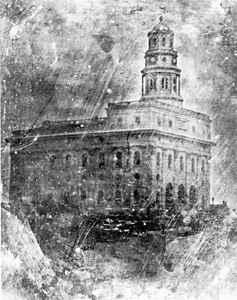
Church History c. 1831-1844, Ohio, Missouri, And Nauvoo Periods |

A daguerreotype of the Nauvoo Temple (c. 1846). The Latter-day Saints worked to complete this building and receive the ordinances of the temple before they left Nauvoo for the West. The temple was completed in 1846, burned by an arsonist in 1848, largely demolished by a tornado in 1850, and completely leveled in 1856 for safety reasons.
by Milton V. Backman, Jr. and Ronald K. Esplin
In October 1830 four LDS missionaries on their way to preach to the Indians west of Missouri (see Lamanite Mission) introduced the restored gospel to the communities of northeastern Ohio. Before they resumed their journey, the missionaries baptized approximately 130 converts, organized the new members into small "branches," and appointed leaders over each group. Approximately thirty-five of these members lived in Kirtland, Ohio, a community directly east of what is today metropolitan Cleveland.
Sidney Rigdon, a restorationist preacher in that vicinity, joined the Church in November 1830 and notified Joseph Smith of the missionaries' success. As a result, the Prophet inquired of the Lord and recorded revelations (D&C 37:3; 38:32) calling the converts of the recently organized Church in New York to "assemble together at the Ohio." He and his family moved to Kirtland by early February 1831, and about two hundred New York Saints followed by summer, making northeastern Ohio the first LDS gathering place.
Most of the New York Saints and many of the earliest Ohio converts did not remain in Ohio. In the summer of 1831, Joseph Smith traveled to the Missouri frontier and identified Independence, Jackson County, Missouri, as a second gathering place. Latter-day Saints anticipated that a holy city, a New Jerusalem, would be established in a new North American Zion, a city of refuge from tribulations that would afflict the wicked in the last days (D&C 29:7-9; 45:65-71; 57:1-3). Sidney Rigdon dedicated the land for gathering, and Joseph Smith designated the specific site where a temple would be built, and, after appointing others to supervise the gathering to Zion, returned to Ohio.
In Hiram, Ohio, a rural farming community about thirty miles south of Kirtland, Joseph Smith worked on his inspired translation of the Bible (see Joseph Smith Translation of the Bible [JST]), a project that served him as a school. Prayerfully seeking enlightenment about particular passages and doctrines frequently brought new revelation and understanding. After the Prophet and Sidney Rigdon, who was serving as his scribe, were beaten and tarred and feathered by a mob in March 1832, they and their families moved to Kirtland.
The two gathering places of the early 1830s each had a different purpose. Although Latter-day Saints migrated to the Missouri frontier to lay the foundations of a new Zion, the administrative headquarters of the Church, responsible for directing the missionary program and building the first temple, remained in Ohio. There was some competition between the two centers, with both needing resources and members and both wanting the presence of the Prophet Joseph Smith. But, as revelation made clear, the goals of the two were complementary: the promised "endowment from on high" associated with the Kirtland Temple was a prerequisite for success in Zion (D&C 105:9-13, 33). Joseph Smith resided in Kirtland until 1838, keeping in touch with Missouri members by mail and messenger, and traveling there five times to instruct Church members on policies, programs, and beliefs.
In Jackson County, Latter-day Saints published two periodicals, the evening and the morning star and the Upper Missouri Advertiser, and attempted to establish a unique economic order based on consecration with assigned stewardship of property and other assets, as directed by revelations to Joseph Smith (see Missouri: LDS Communities in Jackson and Clay Counties). Disagreements about legal requirements and individual selfishness hampered implementation, but the basic impediment was that the Saints had too little capital and very little to consecrate. Still, some participants were inspired by the concepts involved, and the ideals behind the effort left a significant legacy (see United Orders).
Although the Latter-day Saints migrated to western Missouri to build a city of peace and refuge, they encountered major hostility. Older settlers considered these newcomers a threat to their own patterns of living. Missourians complained that Mormons sought to influence slaves, that their "eastern" lifestyle was incompatible with the Missouri frontier, that they were an economic and political threat, that their friendship for the Indians threatened the region's security, and that they held unusual religious beliefs. These charges indicate a significant cultural clash between the LDS immigrants and older settlers. Rapid immigration of Latter-day Saints into Jackson County intensified the tensions, resulting in confrontation.
After violence erupted in the summer of 1833, Governor Daniel Dunklin sent a local militia into the area to establish peace. Assuming that the militia would protect all settlers, Latter-day Saints surrendered their arms to this military force. But other Missourians were not disarmed, leaving Church members defenseless. In early November 1833, mobs drove more than a thousand Latter-day Saints from Jackson County, forcing them to abandon their homes and farms. Most of them escaped across the Missouri River to Clay County.
Between November 1833 and the summer of 1836, Clay County was the major gathering place for Latter-day Saints in Missouri. During these years, Church members tried but failed to secure redress for the loss of property in Jackson County. They also sought government protection for an attempt to return to their lands. In 1834, believing that Governor Dunklin had agreed to extend the assistance of state militia to reinforce their own efforts, Church members assembled a small paramilitary force from Ohio and elsewhere to accompany the Missouri refugees back to Jackson County. Zion's Camp, as the expedition was called, failed to obtain gubernatorial support and disbanded in June rather than initiate armed conflict.
Though it failed in its primary aim, Zion's Camp profoundly affected many participants and had lasting significance. For most, the hurried March from Ohio to Missouri, more than 800 miles in humid heat, was the most difficult physical challenge of their lives. Some had even greater difficulty with the realization that in spite of that ordeal, they had not assisted the Missouri Saints to return to their lands. They found fault with Joseph Smith's leadership, and the experience contributed to their later dissent. But for many participants, Zion's Camp was an unparalleled opportunity to live day and night with the Lord's prophet—reminiscent of ancient Israel under Moses. The experience bonded them to Joseph and to each other, and out of the crucible of Zion's Camp came many future LDS leaders. The two reactions reflected differing views about prophetic leadership and about how a society based on revelation and priesthood should be organized—differences that became more pronounced in later Kirtland.
The revelation disbanding Zion's Camp refocused attention on Ohio and on the necessity of completing the Kirtland Temple without delay (D&C 105). Before returning to Ohio, Joseph Smith organized a Missouri stake and appointed a presidency and high council, matching what he had done in Kirtland the February before. Soon, several Missouri Church leaders left for Kirtland to assist with temple construction.
All parties concerned had viewed the Saints' stay in Clay County, Missouri, as temporary. With a return to Jackson County now unlikely, pressures mounted for them to find another location. Urged by community leaders to leave before violence erupted, most Latter-day Saints migrated northward, establishing a new western headquarters at Far West, Missouri. Responding to this movement of thousands of Latter-day Saints into unsettled northwestern Missouri, the state legislature in late 1836 created two new counties, Caldwell and Daviess (see Missouri: LDS Communities in Caldwell and Daviess Counties). Since most Latter-day Saints settled in Caldwell, it became known as the Mormon County.
Joseph Smith later taught that a primary purpose for the gathering of the faithful in any age was to build a house of the Lord wherein could be revealed the ordinances of his temple. As temple construction progressed, the LDS population in Kirtland multiplied from about 100 in 1832 to over 1,500 in 1836. Latter-day Saints migrated there from New England, New York, and elsewhere to assist in building the Lord's house, in which, they had been promised as early as January 1831, they would be "endowed with power from on high" (D&C 38:32).
In March 1836 the Kirtland Temple was completed and dedicated, and during the months before and after the dedication, the Saints enjoyed an unusual pentecostal season. In the temple, a week after its dedication, keys of the priesthood were conferred on Joseph Smith and Oliver Cowdery in visitations by Moses, Elias, and Elijah. Blessings and instructions received in the temple were particularly significant for missionaries (see Mission), whose proselytizing travels from Kirtland during the 1830s ranged from Canada to the American South and, in 1837, to the British Isles, with extensive missionary work within Ohio.
While its headquarters remained in Kirtland, the Church experienced major doctrinal and administrative development. A number of the most significant revelations in the Doctrine and Covenants were received in the Kirtland and Hiram areas, including the vision of the Resurrection and the three degrees of glory (D&C 76); the law of consecration and stewardship (D&C 42); the Word of Wisdom, sometimes called the Lord's law of health (D&C 89); revelations on the priesthood and its organization (D&C 84, 107); and the coming of the Millennium (D&C 1, 29, 88, 133). Many of these revelations came in response to questions raised by Joseph Smith's translation of the Bible. Joseph Smith also received a revelation relating to plural marriage (D&C 132), but it was not recorded until 1843. The book of Abraham, not published until 1842, resulted from the Prophet's acquisition in 1835 of a collection of mummies and papyri from Egypt.
As growth required organizational development, a series of revelations directed the establishment of both local and general Church officers. These included the office of bishop in 1831, the First Presidency of the Church in 1832, and a permanent high council in 1834. In February 1835 the Quorum of the Twelve Apostles and the Quorum of the seventy were organized, selected principally from Zion's Camp veterans. Both quorums had responsibility for proselytizing. Though the Twelve were spoken of as second to the Presidency, their immediate assignments were to supervise the labors of the Seventy and to oversee the Church outside its organized stakes.
Revelation also directed officers of the Church to study widely in many fields of knowledge in preparation for their ministries and directed that a School of the Prophets be organized for that purpose (D&C 88:77-80, 118-141). The attitudes and imperatives expressed in the revelation became influential not only in instituting that first Church-sponsored school but also in the Church's approach to learning and education throughout its subsequent history.
Publication of the Evening and the Morning Star, disrupted in Missouri by the expulsion from Jackson County, was resumed for nearly a year in Kirtland. The Latter Day Saints' messenger and advocate, successor to the Star, was the first Church periodical to publish some of Oliver Cowdery's letters dealing with the history of Joseph Smith. The Doctrine and Covenants, containing many of the revelations given to Joseph Smith, was published in Kirtland in 1835.
The promulgation of new doctrine and the establishment of a church hierarchy offended some Latter-day Saints who preferred the less complicated faith they had embraced in the Church's infancy. Those who did not share the Prophet Joseph Smith's vision of a new society organized under priesthood were also disturbed by the increased direction Church leaders gave members in temporal matters and by the Prophet's extensive involvement in economic affairs. The collapse of an unchartered Kirtland Safety Society that had been sponsored by Church leaders helped bring discontent to a head (see Kirtland Economy). Lawsuits were filed against Joseph Smith, threats were made against his life, and against the lives of his most vigorous supporters, and a number of prominent Church members apostatized. In the midst of this turmoil, the Prophet sent some of his staunchest supporters as missionaries to the British Isles. There, in less than a year, they gained more than 1,500 converts and laid the groundwork for thousands more to follow (see Missions of the Twelve to British Isles).
By 1837, Latter-day Saints outnumbered other residents of Kirtland Township. That year, LDS candidates were elected to all major town offices except that of constable. Many Church members in Kirtland were relatively poor and lived in clusters of small temporary homes. Some non-Mormons became resentful of this influx of the poor and of Church leadership that seemed undemocratic and thus un-American. Economic and political rivalries developed, accompanied by threats and some mob violence. Outside pressure mounted for the removal of the Mormons from Kirtland at the same time as bitter internal dissension plagued the Church. In January 1838, Joseph Smith, Sidney Rigdon, and other Church leaders whose lives had been threatened fled to western Missouri, followed gradually by most of the Latter-day Saint residents of Kirtland and vicinity.
In 1837-1838, LDS migration into western Missouri increased rapidly. This growth sparked increased agitation among neighbors who feared Mormon economic and political domination and who saw the influx as a threat to their way of life. Grievances that had been expressed by Jackson County citizens in 1833 were repeated and enlarged. Rumors and accusations became the basis for intolerant actions. Some insisted that since Caldwell County had been created for Mormons, Latter-day Saints were not to settle outside the borders of that county.
The decisive confrontation was sparked by a fight that erupted when ruffians attempted to prevent LDS voting at Gallatin, Daviess County. Exaggerated reports of this melee unloosed agitation that had been mounting and led to the formation of mobs determined to drive all Mormons from Daviess County. Mobs also threatened Latter-day Saints living in DeWitt, Carroll County, until, on October 11, 1838, they were forced to leave their homes and farms. As the refugees traveled to the LDS stronghold at Far West, they were continually harassed and several died.
After Governor Lilburn Boggs refused pleas to protect the DeWitt Saints, Church leaders mobilized the Caldwell County militia and prepared to protect themselves. Some members of the Danites, originally organized to assist with Latter-day Saint community development, engaged in paramilitary activity, including burning the headquarters of mobbers at Gallatin and Millport who had threatened their destruction. Meanwhile, a local militia forced Latter-day Saints to leave their farms in Ray County and threatened to shoot Church members accused of being spies. Trying to prevent the threatened executions, a unit of the LDS Caldwell County militia engaged the Ray militia on October 25 at Crooked River. Men were killed on both sides, and wildly exaggerated rumors of marauding Mormons enflamed the countryside. On October 27, without investigating the charges and countercharges, Governor Boggs accused Church members of initiating hostilities and ordered the state militia to exterminate the Mormons or drive them from the state (see Extermination Order). Three days later, the Haun's Mill Massacre, in which more than two hundred militiamen attacked a tiny LDS settlement and brutally killed seventeen, underscored the likelihood that Boggs's order would be carried out literally.
Confronted by overwhelming militia forces, the Latter-day Saints surrendered at Far West and agreed to leave the state. Approximately 10,000 Church members were forced to leave Missouri, most in winter and amid intense hostility. Traveling eastward, they crossed the Mississippi River into Illinois. After suffering immense losses of property and some loss of life, in early 1839 most reached Quincy and other western Illinois communities whose residents offered aid and refuge.
Meanwhile, Church leaders in Missouri were arrested and charged with treason. Most were promptly released, but ten were imprisoned without trial during the winter of 1838-1839, some in richmond jail and others in Liberty Jail. During the Prophet Joseph's half-year stay in Liberty Jail, he wrote some of the most insightful and eloquent inspired writings of his career (D&C 121-23), and he emerged in April 1839 with a clear understanding of what must be done to complete his mission satisfactorily and a firm determination to do so.
The Saints arranged to purchase land for a new gathering place on both sides of a bend in the Mississippi River north of Quincy. Nauvoo, Illinois, superseded the fledgling community of Commerce and became Church headquarters. Many members also settled across the river in Lee County, Iowa.
Plagued by malaria, Nauvoo-area Saints sought to confront larger issues while still struggling to establish a viable community after the Missouri disaster. Attempting to obtain redress for Missouri losses, President Joseph Smith visited national political leaders in Washington, D.C., but the prevailing emphasis on states' rights precluded federal assistance. Despite illness and poverty, nine members of the Quorum of the Twelve Apostles fulfilled an assignment to proselytize in the British Isles. They arrived in England in early 1840 and during the next fifteen months saw nearly 5,000 converts join the approximately 1,500 they found on arrival. The following year, Orson Hyde, an apostle, visited Jerusalem and dedicated Palestine for the gathering of the Jews (see Israel: Gathering of Israel).
In England the Twelve launched the Latter Day Saints' Millennial Star and published a hymnal and a second edition of the Book of Mormon, founding in the process what became a major LDS publication center for the next half century. The Twelve initiated the emigration of LDS British converts to America in 1840, and during the next six years nearly 5,000 migrated to Nauvoo (see Immigration and Emigration). Under the leadership of Brigham Young, the Quorum of the Twelve became an effective administrative force during this mission. When they returned to Nauvoo, they were given new responsibilities. In August 1841, Joseph Smith announced that the Twelve now stood "next to the First Presidency," and their jurisdiction was expanded to include supervision of the Church's stakes as well as mission areas.
Draining the swamps and welcoming a growing number of settlers, the Saints in Nauvoo created a thriving community that eventually numbered nearly 12,000, rivaling Chicago as the largest city in Illinois. Construction and growth fueled the economy, cultural life thrived, and the Saints developed the most important religious community of their short history. Having learned from experience that they could not rely on the goodwill of others for protection, they sought institutional guarantees. In the Nauvoo charters the Illinois state legislature provided the protections of home rule, a municipal judiciary, and a city militia. Determined never again to be defenseless as they had been in Missouri, they built their chartered Nauvoo Legion into the largest militia in Illinois.
To an unusual degree, Joseph Smith occupied a position of political as well as ecclesiastical power, serving at various times as city councilman, mayor, commanding general of the Nauvoo Legion, and editor of the leading local newspaper, the Times and Seasons. These positions gave him wide latitude to build a sacral society and to accomplish the things he felt most central to his mission.
After receiving additional priesthood keys in the Kirtland Temple in 1836, Joseph Smith looked to the day when he could complete his temple-related responsibilities and convey additional teachings and ordinances to the Saints. He emerged from Liberty Jail convinced that his time to do so was short and that Nauvoo would be his last opportunity. As soon as the Saints had regrouped and were secure in their new home, he began unfolding a set of additional teachings, ordinances, and organizational patterns—many of them temple-related—that further distanced the Saints from their own earlier notions and from the beliefs of their neighbors. This process began with an important revelation of January 1841 (D&C 124) that, among other things, launched the construction of the Nauvoo Temple, and continued for more than three years. By April 1844, just three months before his death, the process was complete.
In Nauvoo Joseph Smith expounded on the nature of the Godhead and the origin and destiny of the human race, stressing the concept of eternal progression in conjunction with the Plan of Salvation (see King Follett Discourse). Teaching the universal availability of salvation, he introduced vicarious ordinances for deceased individuals, including baptism for the dead. Experiencing resistance to new doctrines and practices, yet driven by personal forebodings to avoid delay, the Prophet began in 1841-1842 to introduce plural marriage and sacred temple ordinances (see Endowment) privately to a limited number of trusted associates, including members of the Quorum of the Twelve, who were later to deliver them to worthy members of the Church once the temple was complete.
Among the most important Nauvoo organizational developments was the March 1842 founding of the Relief Society, a benevolent, social, and religious organization for women (see Relief Society Organization in Nauvoo). The Relief Society provided women a structure to facilitate charitable work and sisterhood. More important, it brought women into close contact with priesthood organization and helped to prepare them for temple experiences to come. The Church's first wards, or basic congregational units, were founded in Nauvoo, and additional responsibilities for bishops were defined. The council of fifty was the last organizational element set up by Joseph Smith. Though it played a useful practical role for several years after its March 1844 organization, its greatest importance was in providing a governmental model for the future kingdom of God on earth.
From the temple to the Council of Fifty, members of the Quorum of the Twelve Apostles stood by the Prophet as his closest advisers and assistants. Foreseeing the day when the Saints might need a more secure haven in the isolated West, in February 1844 Joseph Smith assigned the Twelve to lead an expedition to find such a location (see Westward Migration), but shortly put the project on hold. First, he wanted them to travel to the East on a more political mission. When inquiries to the presidential candidates in the approaching national election produced no one willing to defend Mormon rights, the Prophet Joseph Smith launched his own presidential campaign, providing a platform for making his views known and speaking out on behalf of his people. During their usual summer proselytizing, the Twelve and other supporters would travel in the East, combining preaching with electioneering. Before they left, about March 26, 1844, Joseph Smith made his "last charge" to the Twelve. He declared that he had now given them every priesthood key that he possessed and that it was their responsibility to shoulder the burden of the kingdom while he rested. Before they returned from the East, he was murdered.
Although Nauvoo grew rapidly, progress on its most ambitious construction projects, the Nauvoo Temple and the Nauvoo house hotel, lagged, in part because of a shortage of capital. Hopes to make Nauvoo a manufacturing center failed to materialize for the same reason (see Nauvoo Economy). But the continued success of LDS proselytizing and the influx of immigrants, combined with LDS solidarity and industriousness, transformed Nauvoo into a formidable economic and political competitor to the other towns in Hancock County.
Neighbors unsympathetic to Nauvoo also had other complaints. The theocratic organization of the LDS community, with its apparent unity of purpose and its local autonomy, aroused resentment. The tendency for Latter-day Saints to vote as a bloc for local and state candidates who were most likely to benefit them alienated both Whigs and Democrats (see Nauvoo Politics). Nauvoo's strong militia aroused envy and distrust. The fact that the city's judicial system shielded Joseph Smith from prosecution provoked charges that he had placed himself beyond the law.
As these things increased the hostility of adversaries of the Church, Thomas Sharp, editor of a newspaper in nearby Warsaw, made his Warsaw Signal a voice for these concerns and took up a sustained crusade against Joseph Smith and Nauvoo. In the spring of 1844 several disgruntled former associates combined forces with anti-Mormons to mount an offensive against the Prophet from within Nauvoo itself. They published the Nauvoo Expositor newspaper, which attacked the Church and made inflammatory charges against Joseph Smith. The Nauvoo City Council declared the paper a public nuisance and ordered the sheriff to destroy it, an action that aroused the Prophet's enemies and provided the basis for his arrest. On June 27, 1844, Joseph and his brother Hyrum were murdered in the jail at the county seat, Carthage, while awaiting trial (see Carthage Jail; Martyrdom of Joseph and Hyrum Smith).
The Prophet Joseph Smith established the doctrinal and organizational foundation of the modern Church and prepared Brigham Young and the Quorum of the Twelve Apostles to build on the foundation he had laid (see Succession in the Presidency). His ministry and his mission were complete.
(See Daily Living home page; Church History home page; 1831-1844 home page)
Illustrations
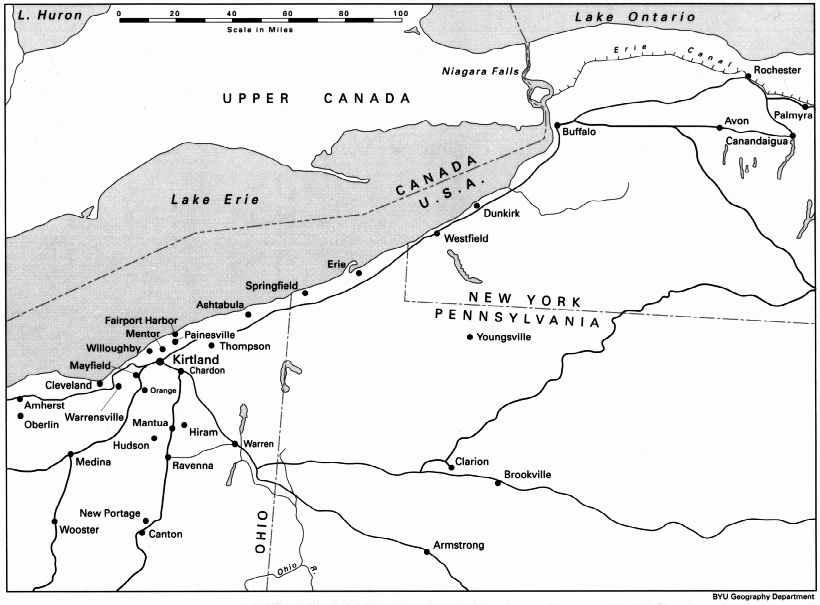
Western New York and eastern Ohio. Towns and routes, 1831.
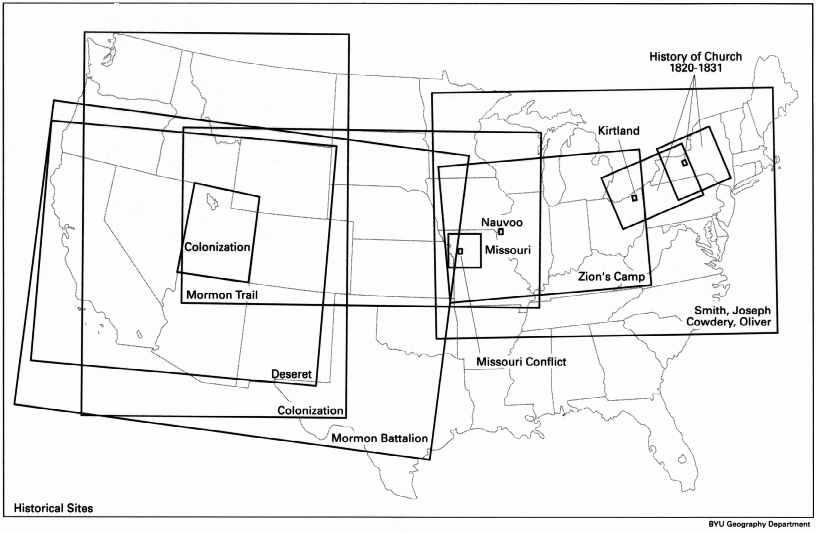
Overview of LDS historical sites, 1805-1900.
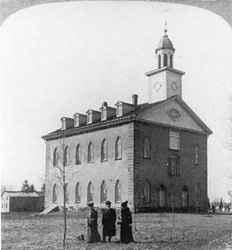
Kirtland Temple, dedicated 1836. Building the Kirtland Temple was of central importance to the Saints in the mid-1830's, so that they could receive there the promised blessings from on high before taking the gospel to the ends of the earth. Photographed c. 1900. Courtesy Rare Books and Manuscripts, Brigham Young University.
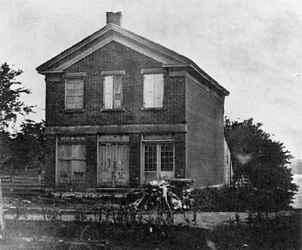
Joseph Smith's red brick store (1885; built, 1842; restored, 1978-1979) was an important building during the Nauvoo period. It was a center of social, economic, political, and religious activity. Joseph Smith's office and meeting room on the second floor became the headquarters of the Church, and the first endowments were given there. In 1842, the Relief Society was organized there. B. H. Roberts collection.

Joseph Smith Directing the Nauvoo Legion, by John Hafen (1887, oil on canvas, 19"x 25"). Joseph Smith in Nauvoo, with the Nauvoo Temple in the background (completed after his death). Joseph Smith was the central religious and political leader of the LDS community in Nauvoo, Illinois, and commander of the Nauvoo Legion. Courtesy Utah State Historical Society.
Bibliography
Allen, James B., and Glen M. Leonard. The Story of the Latter-day Saints. Salt Lake City, 1976.
Backman, Milton V., Jr. The Heavens Resound. Salt Lake City, 1983.
Flanders, Robert Bruce. Nauvoo: Kingdom on the Mississippi. Urbana, Ill., 1965.
Gentry, Leland H. "A History of the Latter-day Saints in Northern Missouri from 1836 to 1839." Ph.D. diss., Brigham Young University, 1965.
Hill, Marvin S. Quest for Refuge. Salt Lake City, 1989.
LeSueur, Stephen C. The 1838 Mormon War in Missouri. Columbia, Mo., 1987.
Pratt, Parley P. Autobiography of Parley P. Pratt. Salt Lake City, 1985.
Underwood, Grant. "Millenarianism and the Early Mormon Mind." Journal of Mormon History 9 (1982):41-51.
Encyclopedia of Mormonism, Vol. 2, History of the Church
Copyright © 1992 by Macmillan Publishing Company
All About Mormons |